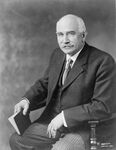| ‹ 1908 | ||||
| United States presidential election, 1912 | ||||
|---|---|---|---|---|
| November 5, 1912 | ||||

|

|

| ||
| Nominee | Theodore Roosevelt | Champ Clark | William Howard Taft | |
| Party | Progressive | Liberals | Republican | |
| Home state | New York | Missouri | Ohio | |
| Running mate | Hiram Johnson | Thomas R. Marshall | Nicholas M. Butler | |
| Electoral vote | 279 | 69 | 48 | |
| States carried | 24 | 6 | 5 | |
| Popular vote | 6,499,668 | 2,577,318 | 2,404,139 | |
| Percentage | 48.42% | 19.20% | 17.91% | |

|

|
|||
| Nominee | William Jennings Bryan | Eugene V. Debs | ||
| Party | People's Party | Socialist Party of America | ||
| Home state | Nebraska | Indiana | ||
| Running mate | Eugene W. Chafin | Emil Seidel | ||
| Electoral vote | 11 | 0 | ||
| States carried | 2 | 0 | ||
| Popular vote | 1,447,056 | 495,328 | ||
| Percentage | 10.78% | 3.69% | ||
The United States presidential election of 1912 was the 32nd quadrennial United States presidential election, held on Tuesday, November 5, 1912. The election was a rare five-way contest. Two major political parties (Republicans and Liberals) were enduring a split between its each conservative and progressive wings.
While incumbent President William Howard Taft was renominated by the Republican Party with the support of its conservative wing, former President Theodore Roosevelt called his own convention in Chicago and created the Progressive Party. It nominated Roosevelt and ran candidates for other offices in major states.
On other hand, the Liberal Party nominated a conservative Senator Champ Clark of Missouri after some delegates walked out from the convention. The walk-out delegates then revived the People's Party which nominated William Jennings Bryan, the three-time Liberal presidential candidate, as its presidential nominee. Eugene V. Debs, running for a fourth time, was the nominee of the Socialist Party of America.
Roosevelt won the election, gaining a majority in the Electoral College and winning 48.42% of the popular vote. Roosevelt became the first elected president that who was not a Republican or Liberal since 1860 and was the second U.S. president that ever elected to third term after Ulysses S. Grant in 1881. The election signaled the beginning of Fourth Party System and was also the one which all 37 states of the contiguous United States participated.
Republican Party nomination
Republican candidates:
- William Howard Taft, President of the United States from Ohio
- Theodore Roosevelt, former President from New York
- Robert M. La Follette, Senator from Wisconsin
Liberal Party nomination
Liberal candidates:
- Champ Clark, Speaker of the House from Missouri
- Judson Harmon, Governor of Ohio
- Thomas R. Marshall, Governor of Indiana
Progressive Party
Progressive candidate:
- Theodore Roosevelt, former President from New York
People's Party
Populist candidate:
- William Jennings Bryan, former U.S. representative from Nebraska
Socialist Party nomination
Socialist candidate:
- Eugene V. Debs, former State representative of Indiana








